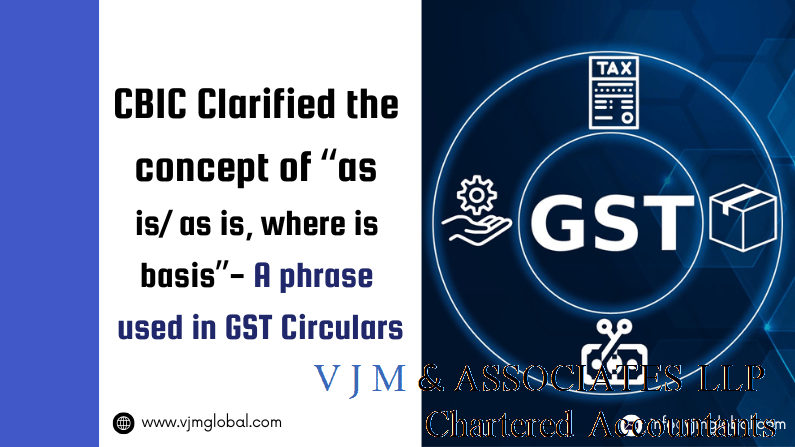
In various GST circulars issued recently concerning clarification on the applicability of GST rates, and clarification on the classification of goods and services, the phrase “as is” or “as is, where is basis” has been used extensively to regularize the matters before the effective date of clarification. The GST Council in its 54th Meeting has recommended issuance of clarification to clarify the intent behind the regularization done in the past meetings. Therefore, CBIC issued the circular to clarify the scope of “as is” or “ as is, where is basis”.
The CBIC has clarified the scope of the “As is” or “as is, where is basis” phrase vide circular No. 236/30/2024-GST dated 11th October 2024.
1. Scenarios where the phrase “as is” or “as is, where is basis” has been used
- These phrases are generally used in the scenarios of short payment of GST or nonpayment of GST.
- GST Council has regularized the compliance done in the past in the following cases:
- where the goods or services were falling under the two different competing entries with different rates; or
- Where GST at different rates has been discharged due to diverse interpretations. Some suppliers have paid GST at a lower rate (including nil rate on account of an exemption entry) and some suppliers have paid GST at a higher rate.
2. No refund shall be granted where taxpayers have paid a higher rate of GST
- Concerning matters regularised on “as is” or “as is, where is basis” CBIC has clarified that where taxpayers had paid at the higher GST rate on account of different interpretations, such taxpayer shall not be entitled to any refund.
3. Interpretation of phrase
- The phrase ‘as is where is’ is generally used in the context of the transfer of property and means that the property is being transferred in its current condition, whatever this condition happens to be and the transferee of the property has accepted it with all its faults and defects, whether or not immediately apparent.
- In the context of GST, the phrase ‘regularized on as is where is’ basis means that the payment made at a lower rate or exemption claimed by the taxpayer shall be accepted without any additional liability.
- In case of tax paid at the higher rate, no refund shall be made.
- The intention of the Council is to regularize payment at a lower rate including nil rate due to the tax position taken by the taxable person, as full discharge of tax liability.
- The tax position taken by the taxpayer can be established through returns filed by the person.
- Accordingly, tax payment at a lower rate shall be considered as discharge of full GST liability.
4. Examples:
a. Where a taxpayer has paid a Lower rate of GST
- GST on product “X” is discharged at the rate of 5% by some taxpayers and at the rate of 12% by other taxpayers.
- GST Council recommends reducing the rate to 5% prospectively and regularizing the past on an “as is where is basis” which is notified on 1.12.2023.
- Therefore, for the period prior to 1.12.2023, the 5% GST paid by taxpayers will be treated as tax fully paid and they will not be required to pay duty differential tax of 7% (12% – 5%).
- Further, taxpayers who have paid 12% GST shall not be entitled to a refund.
b. Where taxpayers have paid the NIL rate of GST
- GST on product X is discharged at 5% by some taxpayers, while some have paid nil duty due to the genuine doubt that there is an exemption entry for product X…
- The GST Council clarified that GST at the rate of 5% is applicable and past matters shall be regularized on an “as is where is basis”.
- Accordingly, for the period before the date of notification, taxpayers who have not paid GST and declared such supply as an exempted supply in their return shall be treated as a full discharge of tax liability. Therefore, they will not be required to pay a differential tax of 5% (12% – 5%).
- For those taxpayers who have paid 5%, no refund would be made.
c. Where taxpayers have paid different rates including the NIL rate
- Where interpretation issues exist between two different rates, e.g., GST on product X has been discharged at 5% by some taxpayers and 12% by some taxpayers. Whereas, some taxpayers have paid NIL GST based on their interpretations.
- The GST Council clarified that the applicable GST rate is 12% and regularize the past on “as is where is basis” notified on 1.12.2023.
- This means that for the period prior to 1.12.2023, the 5% GST paid by taxpayers will be treated as tax fully paid and they would not be required to pay duty differential GST of 7% (12% – 5%).
- For taxpayers who have paid 12%, no refund would be made.
- However, the regularization would not apply to situations where no tax has been paid. In such cases, the applicable tax i.e. 12% shall be recovered.
Conclusion
Clarifying the meaning and intent of “as is” or “as is, where is basis” phrase has brought a lot of clarity among taxpayers and department officials. This will help to settle the matters where notices were issued for past periods by the department officials on account of GST discharged at lower rates or different rates. Now, all the matters where past transactions have been regularized, all earlier short payments shall be regularized and notices of huge amounts slammed on the companies shall be set aside.
Discover more from reviewer4you.com
Subscribe to get the latest posts to your email.





